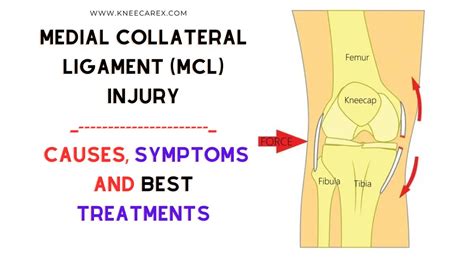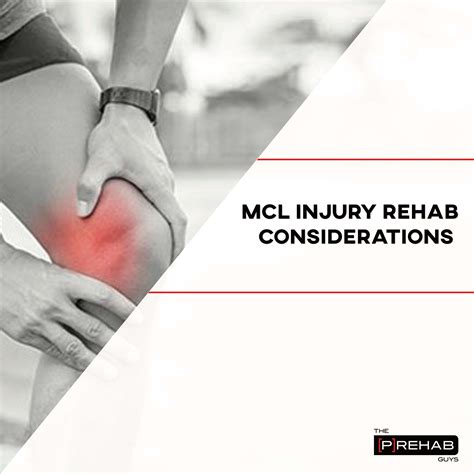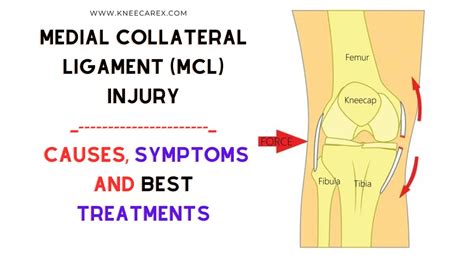Intro
Learn 5 crucial MCL injury tips to aid recovery, including diagnosis, treatment, and rehabilitation techniques for medial collateral ligament sprains and tears, promoting safe and effective healing.
The medial collateral ligament (MCL) is one of the most crucial ligaments in the knee, providing stability and support to the joint. An MCL injury can be a debilitating condition, affecting not only athletes but also individuals who engage in physical activities or experience traumatic knee injuries. Understanding the causes, symptoms, and treatment options for MCL injuries is essential for effective management and recovery. In this article, we will delve into the world of MCL injuries, exploring the anatomy, diagnosis, and rehabilitation of this common knee condition.
The MCL is a ligament located on the inner aspect of the knee, connecting the femur (thigh bone) to the tibia (shin bone). It plays a vital role in maintaining knee stability, particularly during rotational and valgus (inward) stresses. MCL injuries can occur due to various mechanisms, including direct blows to the knee, twisting or bending forces, and sudden changes in direction. Athletes participating in contact sports, such as football, soccer, and hockey, are at a higher risk of sustaining MCL injuries.
MCL injuries can be classified into three grades, depending on the severity of the damage. Grade 1 injuries involve mild stretching or micro-tearing of the ligament, resulting in minimal instability and pain. Grade 2 injuries are characterized by moderate tearing, leading to increased instability and discomfort. Grade 3 injuries involve complete rupture of the MCL, resulting in significant instability and potentially requiring surgical intervention. Accurate diagnosis and grading of MCL injuries are crucial for determining the most effective treatment plan.
MCL Injury Causes and Risk Factors

MCL Injury Symptoms and Diagnosis
MCL injuries can present with a range of symptoms, including pain, swelling, and instability. Pain is typically localized to the inner aspect of the knee, and may worsen with activities that involve twisting or bending. Swelling and bruising may also occur, particularly in more severe injuries. Instability, or a feeling of looseness, may be present, especially in Grade 2 and 3 injuries. Diagnosis of MCL injuries involves a combination of physical examination, imaging studies, and patient history. A thorough physical examination can help identify tenderness, swelling, and instability, while imaging studies, such as X-rays and MRI, can confirm the diagnosis and rule out other conditions.MCL Injury Treatment and Rehabilitation

MCL Injury Prevention and Prognosis
Prevention of MCL injuries involves a range of strategies, including strengthening exercises, flexibility training, and proper equipment use. Strengthening exercises, such as squats and lunges, can help improve knee stability and reduce the risk of injury. Flexibility training, such as stretching and foam rolling, can help improve range of motion and reduce muscle tension. Proper equipment use, such as wearing knee pads and braces, can also help reduce the risk of injury. Prognosis for MCL injuries is generally good, with most individuals able to return to their pre-injury activity level with proper treatment and rehabilitation. However, some individuals may experience persistent symptoms or instability, particularly in cases where there is significant ligament damage.MCL Injury Rehabilitation Exercises

MCL Injury Complications and Future Directions
Complications of MCL injuries can include persistent instability, chronic pain, and limited range of motion. Persistent instability can lead to further injury or degenerative changes, while chronic pain can significantly impact quality of life. Limited range of motion can make it difficult to perform daily activities or participate in sports and exercise. Future directions for MCL injury treatment and rehabilitation include the development of new surgical techniques, advanced rehabilitation protocols, and innovative technologies, such as knee braces and orthotics.MCL Injury FAQs

What is the most common cause of MCL injuries?
+The most common cause of MCL injuries is direct trauma, such as a blow to the knee, particularly in contact sports.
How long does it take to recover from an MCL injury?
+Recovery time for MCL injuries varies depending on the severity of the injury, but most individuals can expect to return to their pre-injury activity level within 6-12 weeks.
Can MCL injuries be prevented?
+Yes, MCL injuries can be prevented by strengthening the muscles around the knee, improving flexibility, and using proper equipment and techniques.
In conclusion, MCL injuries are a common and debilitating condition that can affect individuals of all ages and activity levels. Understanding the causes, symptoms, and treatment options for MCL injuries is essential for effective management and recovery. By following the tips and guidelines outlined in this article, individuals can reduce their risk of MCL injuries and improve their overall knee health. We invite you to share your thoughts and experiences with MCL injuries, and to ask any questions you may have about this common knee condition. By working together, we can improve our understanding of MCL injuries and develop more effective treatment and prevention strategies.
